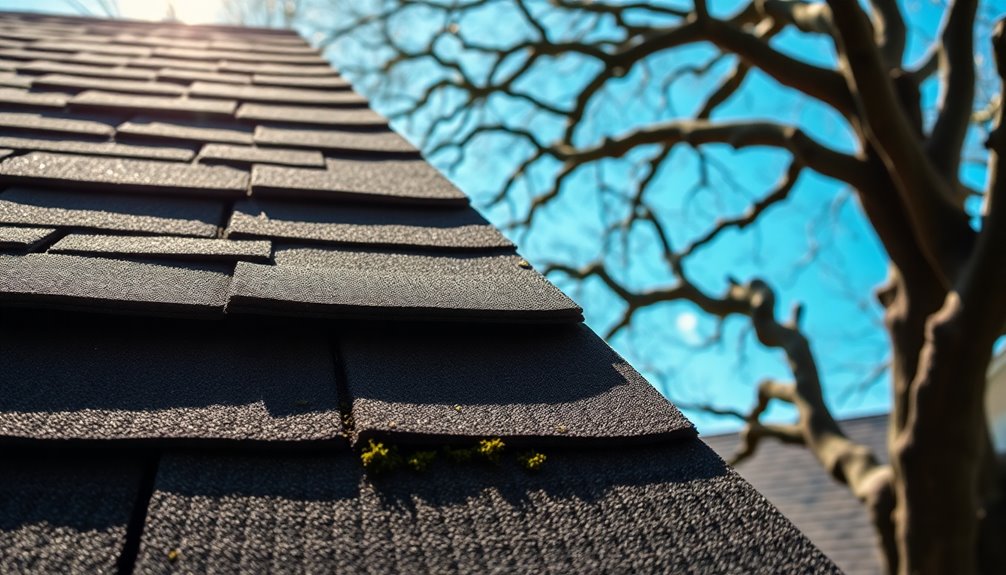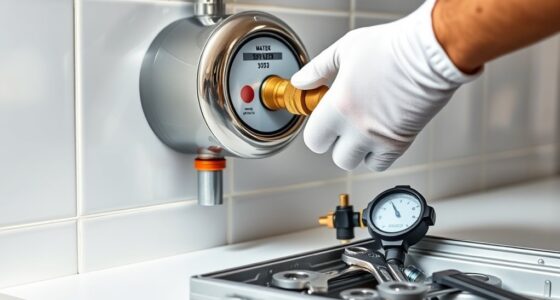30-year architectural shingles typically last 22 to 25 years if you maintain them well. Neglecting maintenance can shorten their lifespan to around 12 to 15 years. The quality of installation plays a big role too; poor installation might cut it down to as little as 10 years. Environmental factors like high winds, UV exposure, and humidity also affect durability. To maximize your shingles' life, regular inspections and prompt repairs are essential. Plus, proper attic ventilation can help prevent premature wear. There's more to discover about shingles and how to keep them in prime condition.
Key Takeaways
- Architectural shingles are marketed as 30-year shingles but typically last 22-25 years with proper maintenance.
- Neglecting maintenance can reduce the lifespan to 12-15 years, while installation quality can lower it to 10-15 years.
- Environmental factors like extreme weather and humidity significantly impact the durability of architectural shingles.
- Regular inspections and prompt repairs are essential for maximizing the lifespan of your shingles.
- Many manufacturers offer limited lifetime warranties that usually only apply to the original homeowners.
Understanding Architectural Shingles
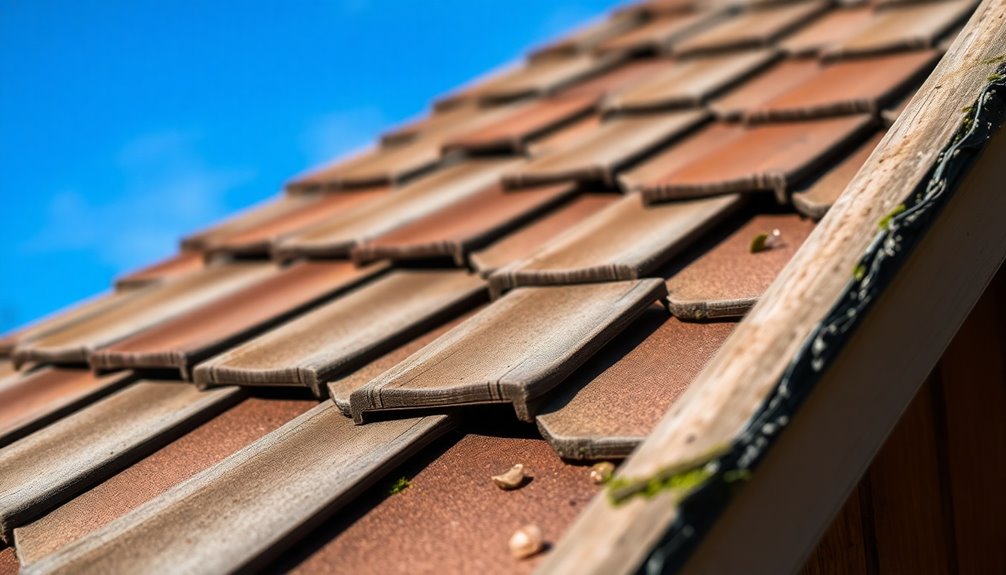
Architectural shingles are a popular choice for homeowners looking to balance durability and aesthetic appeal. These multi-layered shingles provide enhanced weather resistance compared to traditional 3-tab options, making them a solid investment for your roof replacement.
When you choose architectural shingles, you might notice they're often marketed as 30-year shingles, but under ideal conditions, they typically last around 22-25 years. To guarantee you get the most out of your shingles, it's vital to hire a qualified roofing contractor for proper installation.
Additionally, regular maintenance and good attic ventilation can help maximize their lifespan, potentially reaching 80-85% of their rated duration. Many manufacturers also offer a lifetime warranty, giving you peace of mind for your investment.
Actual Lifespan of 30-Year Shingles

When considering the actual lifespan of 30-year architectural shingles, it's important to recognize that their performance often falls short of the advertised duration.
Typically, you can expect 30-year shingles to last around 25 years with proper maintenance. However, neglecting maintenance can drastically shorten this to just 12-15 years.
Environmental factors, like extreme heat or heavy rain, also play a significant role in the longevity of your roofing materials, especially in coastal areas.
To truly maximize the lifespan of your shingles, regular maintenance and timely repairs are essential.
Furthermore, remember that the quality of installation can greatly influence how long your shingles last; poor installation can reduce their life to as little as 10-15 years.
Factors Affecting Shingle Longevity

When it comes to the longevity of your 30-year architectural shingles, several key factors play a role.
The quality of installation, the impact of weather exposure, and your maintenance routine can all greatly affect how long your shingles last.
Understanding these elements can help you maximize their lifespan and protect your investment.
Installation Quality Impact
The quality of installation greatly influences the lifespan of 30-year architectural shingles, as poorly executed work can cut their life expectancy down to just 10-15 years.
When you hire skilled contractors, their expertise guarantees your roofing system is installed correctly, allowing shingles to last 22-25 years or more.
Proper attic ventilation during installation prevents trapped hot air that deteriorates adhesives, markedly extending shingle life.
Additionally, using high-quality underlayment and flashing protects against leaks and enhances durability.
It's also vital to take into account the direction your roof faces; improper installation that overlooks this can lead to premature shingle failure.
Investing in quality installation pays off in the long run, safeguarding your investment and maximizing your shingles' lifespan.
Weather Exposure Effects
Weather exposure plays an essential role in determining how long your 30-year architectural shingles will last. Extreme weather conditions like high winds, hail, and heavy rain can greatly accelerate wear and tear. In sunny areas, UV radiation may reduce shingle lifespan to as little as 15 years without maintenance. Coastal regions face salt air that contributes to corrosion and algae growth. Poor attic ventilation can trap heat, leading to faster deterioration, with some shingles lasting only 10-15 years under such conditions.
| Weather Condition | Impact on Longevity | Recommended Action |
|---|---|---|
| High Winds | Accelerates wear | Regular inspections |
| UV Radiation | Degrades materials | Apply protective coating |
| Salt Air | Causes corrosion | Clean and maintain regularly |
Maintenance Routine Importance
Although many homeowners may overlook it, a consistent maintenance routine is essential for maximizing the lifespan of your 30-year architectural shingles.
Regular maintenance, like annual inspections and timely repairs, can potentially double their service life. Proper attic ventilation is important; without it, trapped heat may reduce your shingles' expected lifespan to just 10-15 years.
Additionally, routine cleaning to eliminate fungi, such as Gloeocapsa magma, can prevent unsightly streaking and damage. Addressing minor repairs promptly is critical to avoid escalating issues that compromise shingle integrity.
Just as you wouldn't neglect car maintenance, proactive roof care is important. By investing in a reliable maintenance routine, you can expect your shingles to last around 80-85% of their rated lifespan, according to the roofing industry.
Common Misconceptions About Warranties

While many homeowners assume that a 30-year warranty means their architectural shingles will last three decades, that's often a misconception.
In reality, asphalt shingles typically last about 25 years with proper care.
Here are three common misconceptions in the roofing industry:
- Warranties cover installation errors: Most warranties exclude issues caused by poor installation.
- Algae resistance lasts forever: Claims are often valid only for the first two years, with diminishing coverage afterward.
- Lifetime warranties are truly lifetime: They usually only apply to the original homeowner and can be voided under harsh conditions.
Understanding these misconceptions helps you set realistic expectations about your shingles' maximum lifespan and guarantees you make informed decisions moving forward.
Maintenance Tips for Longevity
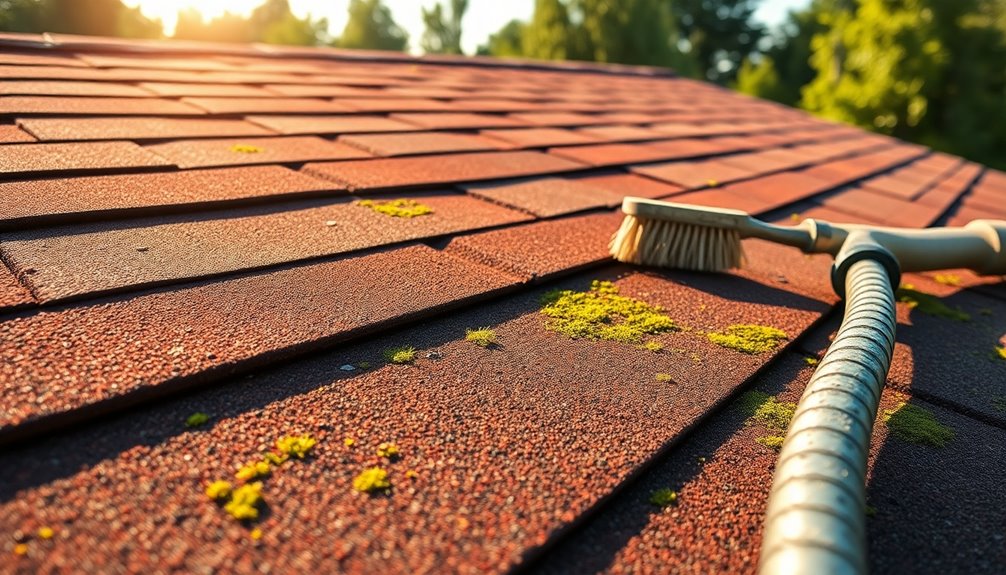
To keep your 30-year architectural shingles in great shape, regular inspections are a must.
Catching issues early can save you time and money, so don't put off those check-ups.
Plus, addressing repairs promptly helps maintain the shingles' integrity and extends their lifespan.
Regular Inspections Required
Regular inspections are essential if you want to maximize the lifespan of your 30-year architectural shingles. Aim for at least one or two inspections each year, and don't forget to check after severe weather.
Here are three key areas to focus on during your inspections:
- Identify shingle damage: Look for missing or cracked shingles that could lead to leaks.
- Consult roofing professionals: They can assess your roof's overall condition and recommend necessary repairs.
- Check ventilation issues: Proper attic ventilation prevents heat and moisture buildup, which can cause premature shingle failure.
Timely Repairs Essential
Timely repairs are essential for maintaining the integrity and longevity of your 30-year architectural shingles. By addressing issues like missing or damaged shingles right after storms, you can prevent further deterioration and extend the lifespan of your roof.
Conduct regular inspections at least once or twice a year to catch potential problems early, ensuring minor issues don't escalate into costly repairs. Additionally, clean your roof periodically to remove debris, moss, and algae, enhancing its durability.
Implementing preventive measures, such as proper attic ventilation, helps reduce heat buildup and moisture, vital for prolonging shingle life.
Finally, always use high-quality materials during repairs and maintenance to achieve better long-term results, keeping your roof functional and visually appealing for years to come.
Signs It's Time for Replacement
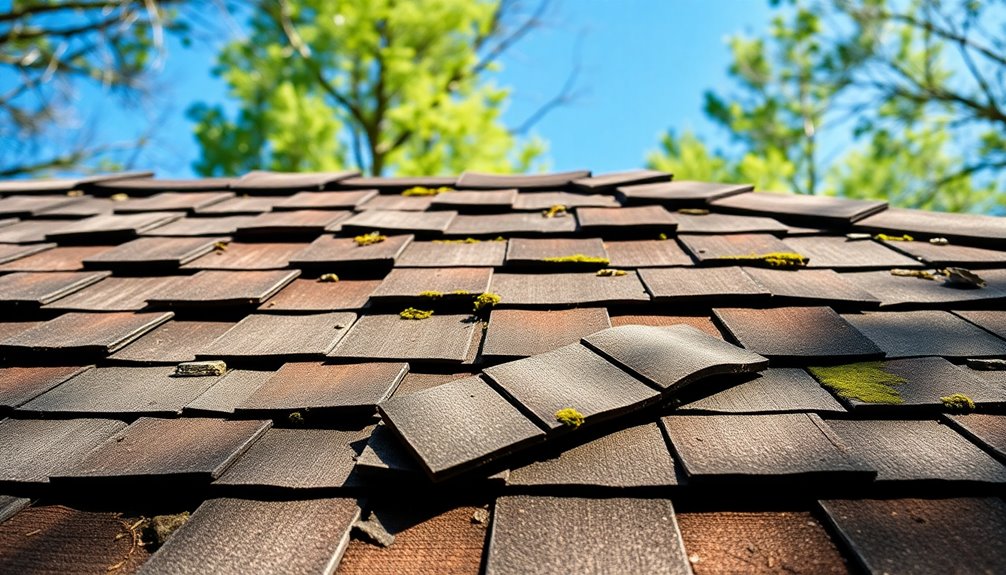
Recognizing the signs that it's time for replacement is essential for maintaining your home's integrity.
As your roof ages, you'll want to look out for these indicators of wear and tear:
- Missing or damaged shingles: If you notice cracked, wavy, or missing shingles, it's a clear sign that your roof may need replacing.
- Leaks or water damage: Check your attic for leaks or signs of water damage; these issues suggest your shingles aren't protecting your home effectively.
- Age of the roof: If your roof is approaching the 20-year mark, it's wise to consult roofing contractors about potential replacement.
Being proactive with these signs can save you from costly roof repair down the line and guarantee your home remains safe and secure.
Impact of Weather on Shingles
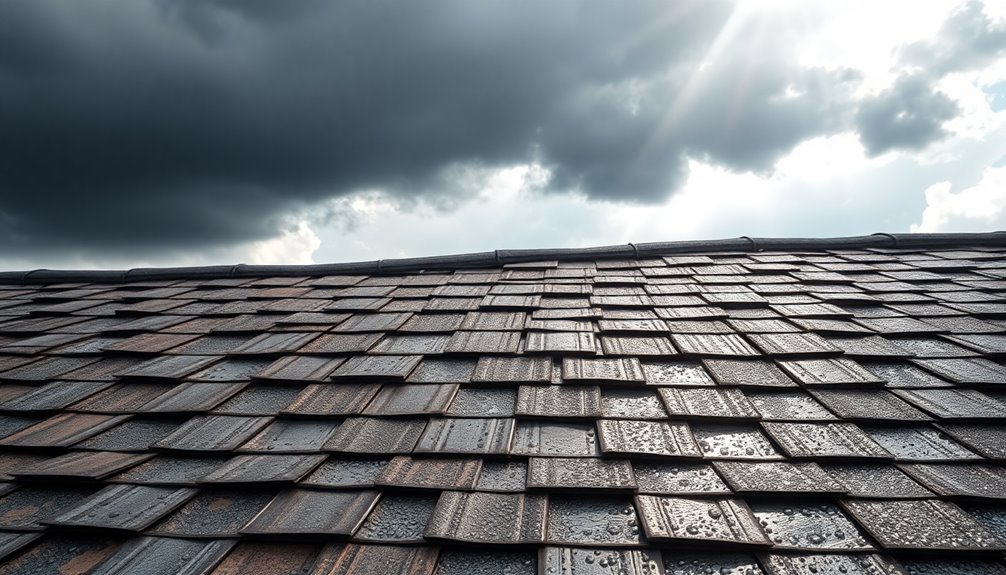
While you may not think about it often, the weather plays an essential role in the lifespan of your architectural shingles. Extreme conditions like heavy rain, high winds, and humidity can greatly impact the longevity of your asphalt roofs. For example, coastal areas often see shingles last only 15 to 25 years due to severe weather.
| Weather Condition | Impact on Shingles | Longevity Effect |
|---|---|---|
| Heavy Rain | Water damage | Decreases lifespan |
| High Winds | Missing shingles | Compromised integrity |
| Humidity | Deterioration | Accelerated wear |
Pay attention to ventilation, too. Poor attic ventilation traps heat, weakening adhesives and further shortening shingle life.
Cost Considerations for New Roofing
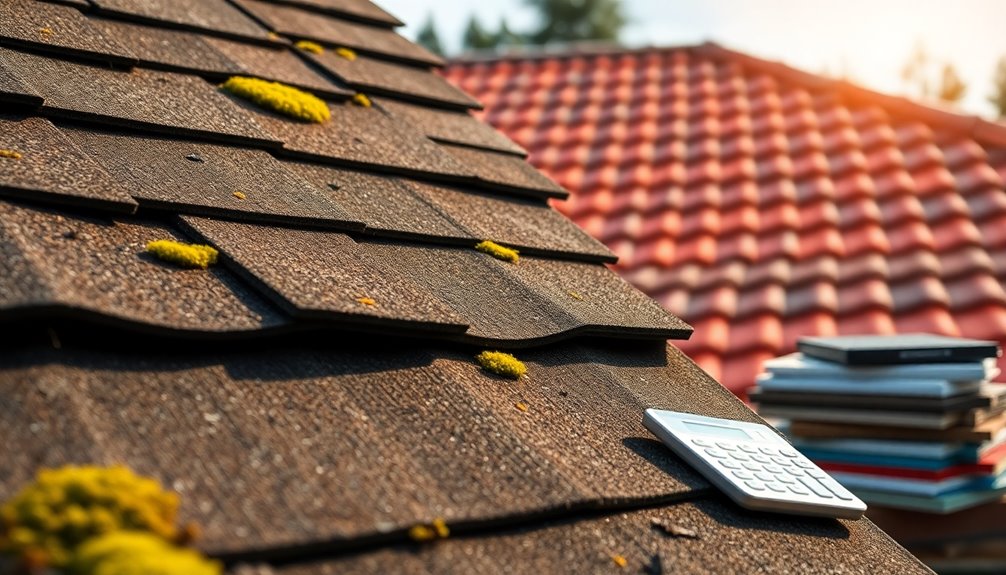
When you're approaching the 20-year mark of your roof's lifespan, it's wise to start budgeting for a replacement.
The cost considerations can vary, especially if you choose architectural shingles. Here are three key factors to keep in mind:
- Material and Labor Costs: Expect to pay between $10,050 and $16,500 for installation, influenced by local market conditions.
- Quality Accessories: Don't forget to include essential roofing accessories like underlayment and flashing in your budget.
- Financing Options: Discuss costs and available financial support with your roofing company to help ease the expense when you replace your roof.
Additionally, consider setting specific savings goals to help manage and allocate funds for this significant investment.
Planning ahead can save you money in the long run, especially with the durability architectural shingles offer.
Types of Architectural Shingles
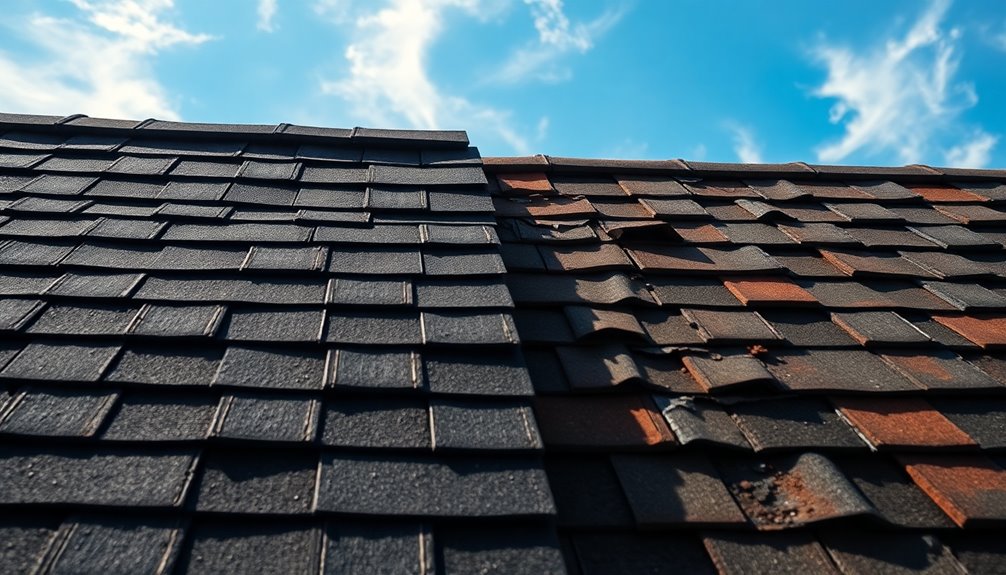
Architectural shingles come in various styles and materials, giving you plenty of options to enhance your home's curb appeal.
These multi-layered shingles offer better durability and resistance compared to traditional 3-tab shingles. You can choose from a range of colors and textures, allowing you to mimic the look of natural materials like slate or cedar shakes.
When you invest in architectural shingles, you'll find that they typically come with warranties rated for 30, 40, or even 50 years, although they may last longer under ideal conditions.
Brands like CertainTeed enhance their shingles with features for improved wind and algae resistance, ensuring your asphalt shingle roof remains reliable and visually appealing for years to come.
Importance of Professional Inspections
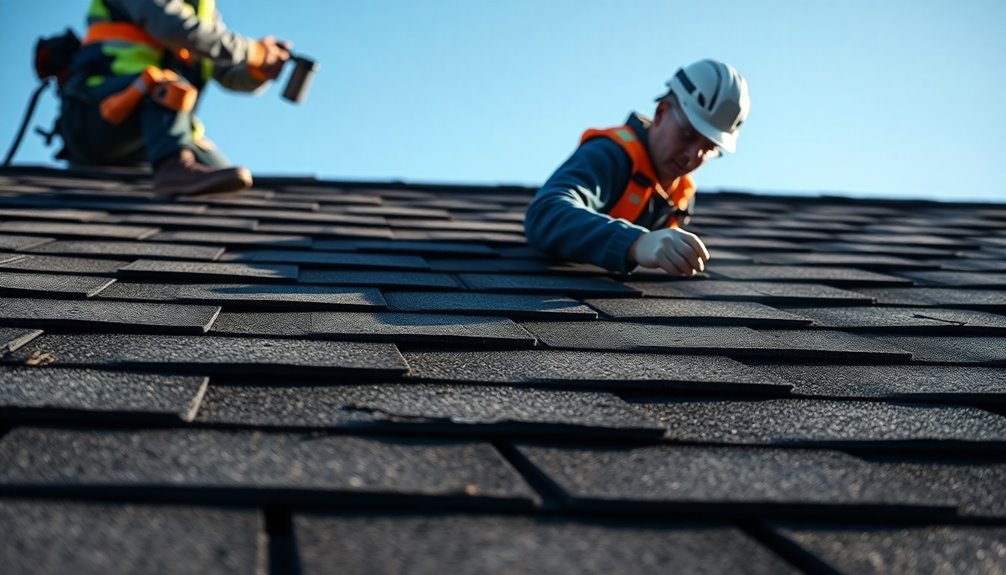
Proper maintenance plays an essential role in maximizing the lifespan of your architectural shingles. One of the most effective ways to guarantee their longevity is through regular professional inspections.
Here's why you should prioritize them:
- Early Problem Detection: Inspections help you identify issues like uneven shingles, leaks, or missing parts before they escalate.
- Quality Assessment: Skilled roofing contractors can assess installation quality and attic ventilation, crucial factors influencing your shingles' durability.
- Cost Savings: Catching storm damage or wear early can save you significant repair costs and prevent premature roof failure.
Don't overlook the age of your roof; inspecting it at least once or twice a year is essential.
Frequently Asked Questions
Can Architectural Shingles Last 30 Years?
You might wonder if architectural shingles can really last 30 years.
While they're marketed as 30-year shingles, the reality is a bit different. With proper maintenance, you can expect them to last around 22-25 years.
However, factors like installation quality, attic ventilation, and extreme weather can shorten their lifespan considerably.
Regular inspections and proactive maintenance can help you maximize their longevity, but you shouldn't rely solely on the advertised lifespan.
How Often Should Architectural Shingles Be Replaced?
Did you know that around 80% of architectural shingles reach only about 22-25 years of their rated lifespan?
You should consider replacing your shingles when they hit around 20 years, as that's a common sign of wear.
Keep an eye out for missing or creased shingles, dark streaks, or leaks.
Regular inspections, ideally once or twice a year, help catch problems early, ensuring your roof stays in good shape long-term.
Are 30 Year Shingles Guaranteed for 30 Years?
No, 30-year shingles aren't guaranteed for 30 years. While they're labeled as that, the actual lifespan often reaches around 25 years with proper care.
Most warranties cover defects but don't assure the shingles will last that long under all conditions. Factors like installation quality and weather exposure play a huge role in their lifespan.
When Should I Replace My 30 Year Shingles?
So, you're waiting for your shingles to sprout wings and fly off into the sunset? Think again! You should replace your 30-year shingles when they hit around 20 years old.
Look for signs like curling, missing pieces, or that delightful algae streaking. If a storm's turned your roof into a dented pancake, it's time to act.
Regular inspections can save you from a rainy day disaster, so don't procrastinate; your roof deserves attention!
Conclusion
In the end, while 30-year architectural shingles promise longevity, their actual lifespan can vary greatly. Keeping an eye on the factors that affect their durability, like weather and maintenance, can make all the difference. Remember, an ounce of prevention is worth a pound of cure; regular inspections and proper care can extend their life considerably. So, stay proactive and invest in your roof to guarantee it stands the test of time. Your home deserves it!
